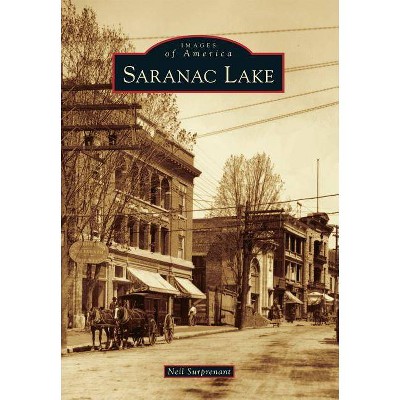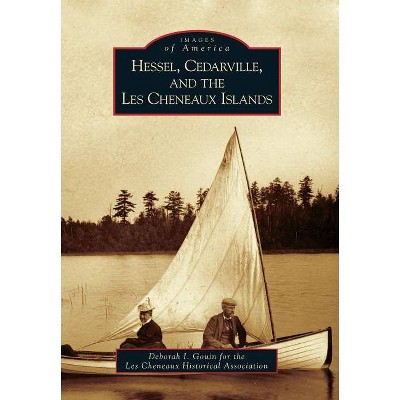Lake Champlain Islands - (Images of America (Arcadia Publishing)) by Tara Liloia (Paperback)

Similar Products
Products of same category from the store
AllProduct info
<p/><br></br><p><b> Book Synopsis </b></p></br></br>On July 3, 1609, French explorer Samuel de Champlain and his group canoed south from Canada into an expansive lake and found four islands. Those islands are now the Lake Champlain Islands, and it was that trip that gave birth to Vermont and sparked 400 years of history. Located in the far northwest corner of the state, the islands are well known as a shoreline retreat for all of New England, with their small-town feel and picturesque farmlands. In this birthplace of Vermont, with its rich soil, early settlers found success growing local varieties of apples, which they shipped by steamboat directly to international cities. Several large deposits of unique, dark limestone brought marble trade to the area, and these materials are still mined in working quarries today. The Lake Champlain Islands are a tranquil, yet vibrant area of Vermont, where historical buildings are often used as schools, museums, libraries, and private homes.<p/><br></br><p><b> Review Quotes </b></p></br></br><br>Title: Lake Champlain Islands <br>Author: Lisa Parsons <br>Publisher: The Hippo Press <br>Date: 3/5/09 <p><br>Lake Champlain Islands (Images of America), by Tara Liloia, 2009, Arcadia Publishing, 127 pages <p><br>Portsmouth Firefighters (Images of America), by Steven E. Achilles, 2009, Arcadia Publishing, 127 pages <p><br>Essex on Lake Champlain (Images of America), by David C. Hislop Jr., 2009, Arcadia Publishing, 127 pages <br>By Lisa Parsons letters@hippopress.com <p><br>The Images of America books, from Arcadia Publishing (which by the way was born in Dover, N.H., and has grown appreciably), are great for any hometown crowd. They include photos that have made their way to the present day by the seat of their pants, getting torn, wrinkled, stained and scribbled on along the way. These are photos that were taken by your great-great-aunt Lula, not by Ansel Adams. <p><br>Of these three just-released installments, Portsmouth Firefighters, by Steven E. Achilles, probably has the smallest, most specialized audience. It would surely be of interest to firefighter wonks, to serious Portsmouth history buffs, and maybe to fans of things with big wheels, but I can t see it being of great interest beyond that. The photos are generally not large enough or clear enough for a layperson to enjoy incidentally, and on the other hand, if you ve seen one wallet-size portrait of a nice mustachioed man from 1920 who had no connection to you, you ve seen them all. What will make this book fun is being able to say I know that building or I know that spot so that s what used to be there or I remember that fire or What a cool engine. <p><br>Lake Champlain Islands similarly will appeal most to those who ve been to the places it depicts, but it also has a broader appeal as general Northeastern American history. Hopefully no one will be misled for too long by the typo that says Samuel de Champlain landed on Isle La Motte in 1906, or the one that implies 1919 came after World War II. I don t care about those typos; the book is worth it for the tidbits of knowledge like that Champlain Black is the only Grade A black marble in the U.S. And it s worth it for the photos of people in horse-drawn carriages in places where I ve driven at 60 mph; the photos of 200-year-old stone school buildings; the photos of generations of activity at Camp Abnaki, where a friend of mine went as a kid; for the photographic history of the ferries on Lake Champlain and the cabins on its shore, not to mention the old and in some cases still-going diners and corner stores. If you have any connection at all to North and South Hero, Alburgh, or Grand Isle, Vermont, you ll want to take a gander at this book. A companion set of 15 postcards is available for $7.99. <p><br>Essex on Lake Champlain looks like summer in sepia (black & white, actually, but it still looks romantic). It includes a nice, detailed map of the historic hamlet of Essex, characterized by picturesque Greek Revival architecture enhanced by its location along a scenic lakeshore set among rolling farmlands all within sight of the Adirondack Mountains. The introduction sketches the region s history, from shipyards (which built some of Commodore Macdonough s ships used in the Battle of Plattsburgh in 1814) through family dynasties and a long but gentle decline into a summer tourist economy. It s a remarkably well-preserved community, retaining a lot of original buildings in or near their original state. The photos of steamboats and ferryboats, thoroughly captioned to tell a real story, broaden the book s appeal. And the pictures of guys riding in horse-drawn sleighs, and guys driving down Main Street in cars that clearly were going ah-OOH-gah, are just cool. <p><br>For those with connections to these places, these newest Images of America books are must-reads, or at least must-look-ats. Your mileage will vary depending on your familiarity with the locale, but overall the Images of America series continues to get an A."<br><br>Title: Lake Champlain Islands <BR>Author: Lisa Parsons <BR>Publisher: The Hippo Press <BR>Date: 3/5/09 <P><BR>Lake Champlain Islands (Images of America), by Tara Liloia, 2009, Arcadia Publishing, 127 pages <P><BR>Portsmouth Firefighters (Images of America), by Steven E. Achilles, 2009, Arcadia Publishing, 127 pages <P><BR>Essex on Lake Champlain (Images of America), by David C. Hislop Jr., 2009, Arcadia Publishing, 127 pages <BR>By Lisa Parsons letters@hippopress.com <P><BR>The Images of America books, from Arcadia Publishing (which by the way was born in Dover, N.H., and has grown appreciably), are great for any hometown crowd. They include photos that have made their way to the present day by the seat of their pants, getting torn, wrinkled, stained and scribbled on along the way. These are photos that were taken by your great-great-aunt Lula, not by Ansel Adams. <P><BR>Of these three just-released installments, Portsmouth Firefighters, by Steven E. Achilles, probably has the smallest, most specialized audience. It would surely be of interest to firefighter wonks, to serious Portsmouth history buffs, and maybe to fans of things with big wheels, but I can't see it being of great interest beyond that. The photos are generally not large enough or clear enough for a layperson to enjoy incidentally, and on the other hand, if you've seen one wallet-size portrait of a nice mustachioed man from 1920 who had no connection to you, you've seen them all. What will make this book fun is being able to say "I know that building" or "I know that spot--so that's what used to be there" or "I remember that fire" or "What a cool engine." <P><BR>Lake Champlain Islands similarly will appeal most to those who've been to the places it depicts, but it also has a broader appeal as general Northeastern American history. Hopefully no one will be misled for too long by the typo that says Samuel de Champlain landed on Isle La Motte in 1906, or the one that implies 1919 came after World War II. I don't care about those typos; the book is worth it for the tidbits of knowledge like that Champlain Black is the only Grade A black marble in the U.S. And it's worth it for the photos of people in horse-drawn carriages in places where I've driven at 60 mph; the photos of 200-year-old stone school buildings; the photos of generations of activity at Camp Abnaki, where a friend of mine went as a kid; for the photographic history of the ferries on Lake Champlain and the cabins on its shore, not to mention the old and in some cases still-going diners and corner stores. If you have any connection at all to North and South Hero, Alburgh, or Grand Isle, Vermont, you'll want to take a gander at this book. A companion set of 15 postcards is available for $7.99. <P><BR>Essex on Lake Champlain looks like summer in sepia (black & white, actually, but it still looks romantic). It includes a nice, detailed map of the "historic hamlet of Essex," characterized by "picturesque Greek Revival architecture enhanced by its location along a scenic lakeshore set among rolling farmlands all within sight of the Adirondack Mountains." The introduction sketches the region's history, from shipyards (which built some of Commodore Macdonough's ships used in the Battle of Plattsburgh in 1814) through family dynasties and a "long but gentle decline" into a summer tourist economy. It's a remarkably well-preserved community, retaining a lot of original buildings in or near their original state. The photos of steamboats and ferryboats, thoroughly captioned to tell a real story, broaden the book's appeal. And the pictures of guys riding in horse-drawn sleighs, and guys driving down Main Street in cars that clearly were going "ah-OOH-gah," are just cool. <P><BR>For those with connections to these places, these newest Images of America books are must-reads, or at least must-look-ats. Your mileage will vary depending on your familiarity with the locale, but overall the Images of America series continues to get an A.<br>
Price History
Price Archive shows prices from various stores, lets you see history and find the cheapest. There is no actual sale on the website. For all support, inquiry and suggestion messages communication@pricearchive.us




















